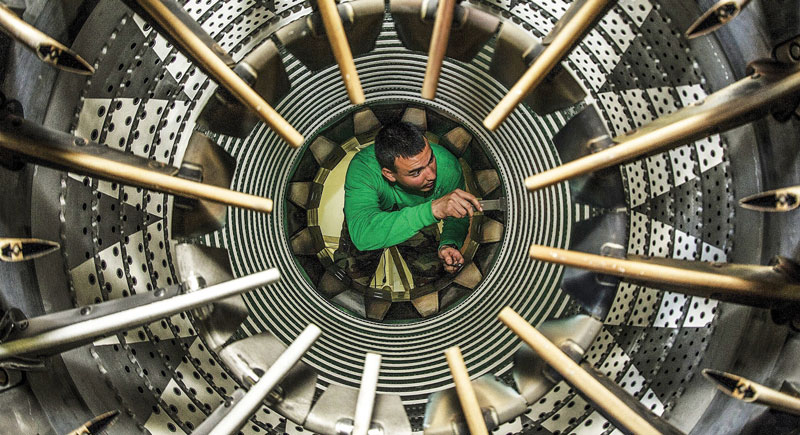Industry 4.0: Maintenance Becomes Predictive
In recent years such terms as Industry 4.0, big data, machine learning and IoT have become very familiar. One concrete application is predictive maintenance, which reduces operating costs and downtime of production assets
An increasing number of companies are discovering that planning and maintenance operations managed in a predictive manner, that is, predicting asset failures and performing maintenance only when absolutely necessary (rather than performing routine preventive maintenance according to a prescribed schedule or corrective maintenance after an asset has actually been stopped), allow plant downtime and overall costs to be minimised.

Preventive and predictive? Characteristics and differences
Basically, predictive maintenance is a maintenance strategy which tries to predict when a component or equipment might fail, so that maintenance can be performed just before this happens. These predictions are based on the state of the equipment, which is evaluated based on data collected through the use of sensors and Condition Monitoring techniques. Ideally, predictive maintenance allows the frequency of maintenance to be minimised to avoid unplanned reactive action in the event of a failure, without however incurring the costs associated with excessive preventive maintenance, which often proves unnecessary. While preventive maintenance is based primarily on industry failure averages, historical data and best practices to guide maintenance decisions, predictive maintenance monitors the actual use of an asset to decide when to take action. Therefore, predictive maintenance requires the assessment of the actual condition of the equipment through periodic or continuous (online) monitoring, and can be performed while the equipment is operating normally to minimise disruption to production operations. Examples of the use of predictive maintenance using sensors include machine vibration analysis, engine oil analysis, thermal imaging to detect abnormal temperatures and equipment observation.

What are the types of maintenance?
Let us briefly review the main types of maintenance. We shall start with the simple Run-to-Failure (RTF) maintenance strategy, which consists of intervening only when the operation of a component or machine is interrupted. This is a fundamentally reactive type of maintenance, in which no maintenance work is carried out until a problem requiring intervention occurs. This is the case, for example, of a burnt-out bulb or a worn gasket which needs to be replaced. We then have preventive maintenance, a maintenance strategy that aims to carry out servicing, replacement or repair work before a component or machine fails. This type of maintenance is very common and easy to understand, because everyone is familiar with it in terms of car maintenance: changing the oil every 15,000 kilometres or every year. Condition-Based Maintenance (CBM) identifies the need for maintenance action based on the current state of health of a component or machine. It envisages the reading of counters and indicators on assets and the activation of work orders when certain values are reached. The state of health of the component is then assessed by correlating one or more physical or chemical parameters to the state of the asset and identifying a threshold value, relative to these values, beyond or below which the asset has a high probability of failure. Finally, Predictive Maintenance (PdM) is performed by measuring and processing one or more parameters to try to calculate the time remaining before failure. Various methods are available for this purpose, such as vibration measurement, thermography, absorbed current analysis, anomalous vibration detection, ultrasound leakage detection and so on. A variation in the values obtained with respect to the normal operating state indicates that critical conditions are approaching, thereby allowing the time of failure to be predicted.

Objective: proactive interventions
In short, the objective of predictive maintenance is to proactively perform maintenance of machines and plants by detecting changes as soon as they occur so as to reduce interruptions and improve the efficiency of the entire plant. This type of maintenance enables scheduled outages of machinery and plants based on actual operating data. This results in reduced service and material costs and increased plant availability. Further advantages are a longer service life of components and machinery, as well as programmable and cost-optimised maintenance.
Intelligent algorithms and virtual sensors transfer information from condition monitoring to predictive maintenance. One example is the sensorless determination of the optimum oil change time based on the oil temperature in a machine. Temperature is a key factor in oil ageing. This information, combined with other equipment specific parameters and specific operating parameters, makes it possible to calculate accurately the time of oil change in order to avoid a machine failure.

Data mining, machine learning and AI: competing technologies
Predictive monitoring requires the use of many competing technologies, such as data mining, machine learning and artificial intelligence to analyse historical data which will be useful in making forecasts. Predictive testing and inspection are based primarily on non-intrusive techniques, visual inspection and performance data to assess machine and plant conditions. This allows the plant manager to replace arbitrarily planned maintenance operations with scheduled operations only when the condition of the equipment requires this to be done. In this way, before there are evident signs of an imminent failure, the necessary spare parts can be ordered and operations can be scheduled to minimise production losses. Although predictive maintenance offers many advantages, some entrance barriers, such as high initial costs and staff training requirements, mean that a careful assessment of the resources to be deployed is required before any implementation. However, according to a report by Market Research Future, the global predictive maintenance market is expected to reach 6.3 billion dollar by 2022. As the research suggests, this increase is driven by a growing focus on reducing operating costs and downtime of production assets.

